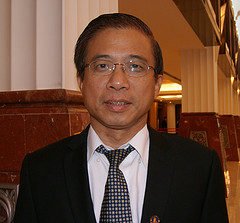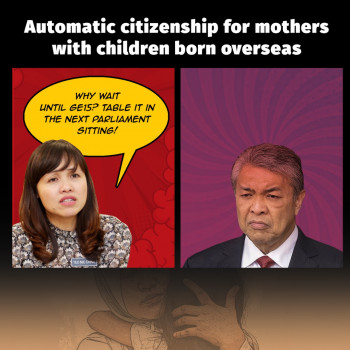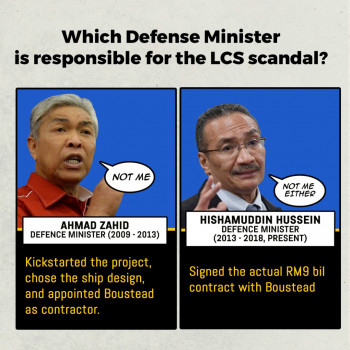 The population growth in Sabah over the past 40 years is so abnormal that many may think that Sabah women are the most productive in the world.
The population growth in Sabah over the past 40 years is so abnormal that many may think that Sabah women are the most productive in the world.
No thanks to the Barisan Nasional (BN) regime, Sabah is the poorest state in Malaysia by a clear margin, but why should there be an outrageous population growth in the state in the last 40 years?
During the Parliament session on 16th March 2011, the Prime Minister’s Department released the following population statistics for the country, concentrating on Sarawak and Sabah, from 1970 to 2010, and the statistics shows that there must be something very wrong in Sabah:
| Year | Malaysia | Sarawak | Sabah |
| 1970 | 10,439,430 | 976,269 (9.35% of total) | 636,431 (6.10% of total) |
| 1980 | 13.1 million (up 2.66m) | 1.2 million (9.16% of total) | 1,011,040 (7.72% of total) |
| 1991 | 17.6 million (up 4.5m) | 1.6 million (9.09% of total) | 1,734,685 (9.86% of total) |
| 2000 | 22,202,614 (up 4.6m) | 2,012,616 (9.06% of total) | 2,488,348 (11.21% of total) |
| 2010 | 27,565,821 (up 5.36m) | 2,420,009 (8.78% of total) | 3,120,040 (11.32% of total) |
| Increment from 1970 to 2010 | 17,126,391 (165%) | 1,433,740 (148%) | 2,483,609 (390%) |
Is there a possible explanation how Sabah’s population grows by 390% in just 40 years?
It matters not a jot that the BN regime had denied this, but one needs only to walk in the streets and back lanes of Sabah, and you are bound to meet face to face many foreigners. They live like Sabahans, in towns, suburbs and floating villages. They are employed in restaurants and cafes, construction sites, markets, timber concessions, factories, road and drain works, fishing trawlers, taxis, godowns and warehouses, school canteens, and even in town halls.
Newspapers have published this often, and the above figures of the Prime Minister’s Department bear testimony, these illegal immigrants have Malaysian identity cards, the “MyKad”! Most ironic, many genuine Malaysians have to wait for years before they get their MyKads.
Worse, many of these illegals are registered voters!
Politicians from the ruling and Opposition parties in Sabah had complained of all these, but the BN Government will simply brush them aside, because these illegal immigrants are BN’s vote bank! They have turned Sabah to become what Najib has called the “BN’s fixed deposit state”!
The fact that these illegal immigrants have outnumbered locals and are competing with local Sabahans for jobs and create social problems is of little concern to the BN. To the BN, political expediency outweighs everything.
Many Malaysians in Sabah and beyond know that the BN Government had registered illegal immigrants as voters. The electoral roll in Sabah had become so foul and doctored that the High Court annulled it and ordered the Likas by-election. The Election Commission owes an explanation why illegal immigrants have been registered in the rolls, only to see the BN use its brute majority in Parliament to legislate that the electoral rolls are henceforth unimpeachable in Court.
Until there is a Royal Commission of Inquiry, we may never know when had the BN Government started legalizing illegal immigrants as voters in Sabah.
It could have been during the Pairin era, when the Kadazandusuns had a political awakening that saw Pairin Kitingan coming to power in Sabah. In order to wrest back the state, something very foul had to be done. Sabahans called it the “Project IC”.
“Project IC” was presented to the Parliament Select Committee on Electoral Reform. All MPs were jubilant when the PSC’s Interim Report that was presented in Parliament in December 2011 proposed for a reconfirmation or revalidation of the electoral rolls in Sabah and the establishment of a Royal Commission to inquire into the countless allegations of illegal immigrants afforded voting rights as phantom voters in Sabah.
The PSC was headed by Datuk Maximus Ongkili, a Sabahan who knows only too well about the influx of illegal immigrants registered as voters in Sabah over the past 4 decades.
But when the Final Report of PSC was tabled in Parliament on 3rd April, 2012, all that were recommended in the Interim Report about reconfirming or revalidating the electoral rolls in Sabah and the establishment of a Royal Commission of Inquiry into illegals becoming voters in Sabah vanished into thin air.
The increase in the population of Sabah owes everything to these illegal immigrants but political expediency rules the day. A clean and fair 13th general election was a foregone conclusion. Najib would not have a Royal Commission to wash the BN’s dirty linen in public.
What about Sarawak? They say statistics do not lie. I am prepared to accept as realistic the growth rate of the national population over each decade. But one also has to consider that compared to the 1970’s, modern families tend to be smaller rather than bigger. An average household size is 4.3 persons (Department of Statistics, 2006) but it might well be closer to 5 persons in the 1970’s. This is particularly valid if one considers that Sarawakians are generally poorer, and poorer families tend to have more children.
I am also prepared to assume that “Project IC” was not a phenomenon in Sarawak, and that there are little geographical differences between Sarawak and Sabah.
Comparing the population growth of Sarawak with the national total, it is not difficult to note the steady decline, from 9.35% of the nation’s population in 1970 to 8.78% 40 years later. On the other hand, Sabah’s population growth registered an upward surge.
I have been to many longhouses all over Sarawak. Many Dayak couples have 6 to 7 children. Malays and Melanaus in Sarawak tend to have big families too. The Chinese have comparatively smaller families.
Overall, I would have been prepared to argue that the ratio of Sarawak’s population vis a vis the national total should at least be maintained at 9.35%.
Should its population be 9.35% of the national total, Sarawak should have a population of 2,577,404 in 2010. There ought to be some explanation to the difference of 157,395. Where have these people gone to?
I told the Dewan Undangan Negeri in November 2011 close to 100,000 Dayaks and anak-anak Sarawak have lost faith in Sarawak, as they seek employment in Singapore, Johor and the Klang Valley. If development distribution is equitable, the children of Sarawak will not have to leave their homeland.
157,395 Sarawakians have voted with their feet, by leaving the state and losing confidence in his Government. I cannot see how the present system will change under the BN Government. A lot of Sarawakians had promised to come back only after the BN has been replaced. I am looking forward to that historic day! –The Rocket



